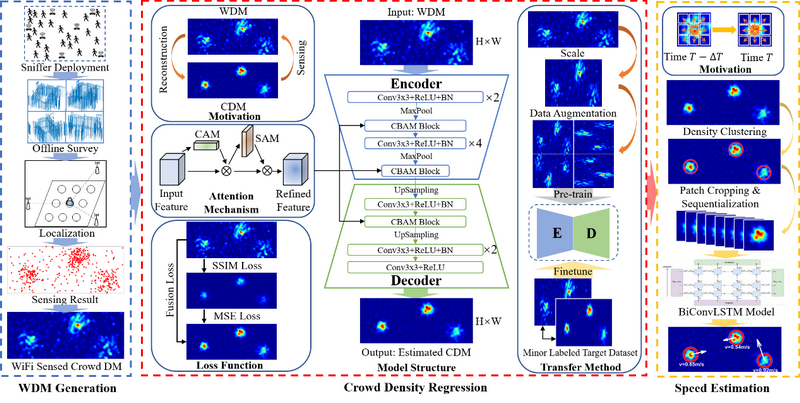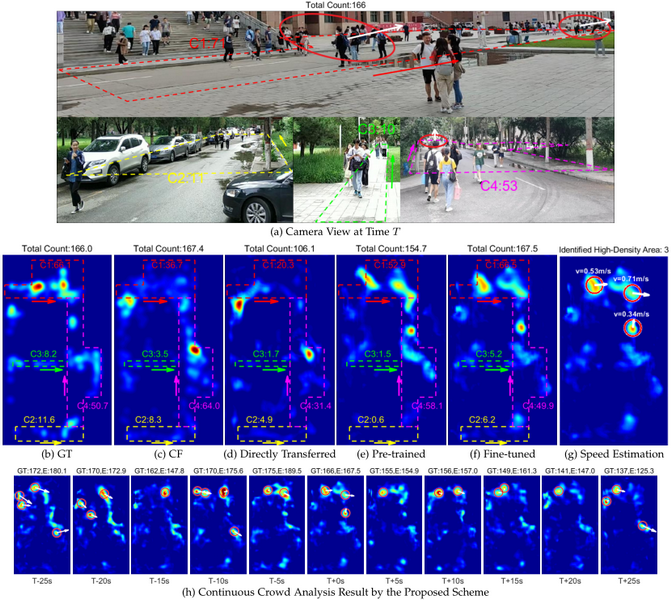Recently, the research team of Prof. Huang Baoqi with the College of Computer Science(CCS) of IMU has made important progress in the WiFi sensing of crowd and research result concerned has been published in IEEE Transactions on Mobile Computing, a class A journal recommended by CCF and an international top journal in computer networks and mobile computing. The result is titled “On the Fine-Grained Crowd Analysis via Passive WiFi Sensing”(URL of the article: https://ieeexplore.ieee.org/document/10285068).
With the increasing popularization of smart devices, people have been used to travelling with smart phones with the WiFi function, which makes it possible to sense pedestrians, even crowd, with WiFi sensing technology. However, influenced by such factors as the randomness of the sensing, randomized MAC addresses and environmental dynamics, the accurate sensing of the real state of the crowd is challenging.

Fig. 1. The fine-grained crowd analysis scheme
Due to this, the research proposes a passive WiFi sensing based fine-grained crowd analysis scheme. On the basis of the deep analysis of the limitations of the sensing and introduction of the rich-information density maps in the field of computer vision to accurately describe the density distribution of the crowd, the research designs an attention-based deep convolutional autoencoder (ADCA) to recover accurate crowd density maps from the sensing data in a way similar to image reconstruction. The research also designs an approach which is based on the combination of density clustering and bidirectional convolutional long-term and short-term memory networks to infer local high-density crowds (LHDCs) speeds with the features of spatial-temporal changes of local density of crowd states. The research develops a probabilistic model-embedded divide and conquer algorithm to produce the semi-synthetic datasets with the generalization of key law of realistic sensing behavior in pedestrian tracking data to fully train, effectively evaluate and transfer the scheme across the domains.

Fig. 2 Verification experiments carried out in the road networks of Inner Mongolia University
To test and verify the research results, the offline sensing data collection system was deployed in the road networks on the campus of IMU which has a covering area of 10,000m² and an effective surveillance area of over 4,000 m² to collect crowd sensing data. The experiment results showed the output of the scheme is consistent with the real crowd states and can provide real-time, continuous, accurate and visualized crowd analysis and satisfy the increasing needs for intelligent crowd surveillance to supply the support of technology and approach in constructing intelligent cities and safe cities.
The research achievement has been jointly made by the research team of Prof. Huang Baoqi with IMU and the research team of Prof. Mao Guoqiang who is IEEE Fellow and dean of the Research Institute of Smart Transportation with Xidian University. Prof. Huang Baoqi is the corresponding author of the article. Hao Lifei, PhD student admitted to IMU in 2019, is the first author. Associate Professor Jia Bin is the third author. IMU is the institution the first author is with. This research is supported by the National Natural Science Foundation of China (Grant Numbers: 62262046, 42161070, U21A20446) and the Major Program of Natural Science Foundation of Inner Mongolia Autonomous Region of China (Grant No. 2021ZD13). Besides, this series of research have made the following achievements.
In August 2023, a passive WiFi sensing based approach for the estimation of the scale of a large crowd was proposed. The research results concerned were published in IEEE Transactions on Intelligent Transportation Systems, an international top journal in smart transportation system which is recommended by CCF as Class B journal and listed in Section I of SCI journals of Chinese Academy of Sciences. The results are titled “Toward Accurate Crowd Counting in Large Surveillance Areas based on Passive WiFi Sensing”(URL of the article: https://ieeexplore.ieee.org/document/10225447). The research was jointly completed by the research team of Prof. Huang Baoqi of IMU and Prof. Mao Guoqiang with Xidian University. Huang is the corresponding author of the article. Hao Lifei, a PhD student admitted to IMU in 2019, is the first author of the article and IMU is the institution the first author is with.
In March 2023, a passive WiFi sensing based approach for the estimation of the online public transit ridership was proposed. The article concerned was published in IEEE Transactions on Intelligent Transportation Systems and titled “Online Public Transit Ridership Monitoring through Passive WiFi Sensing”( URL of the article: https://ieeexplore.ieee.org/document/10078725). The research was completed solely by the research team of Prof. Huang Baoqi. Prof. Huang is the corresponding author. Wen Bo, PhD student admitted to IMU in 2022, is the first author of the article and IMU is the institution the first author is with.
A brief introduction to the corresponding author: Prof. Huang Baoqi who is with CCS, is a PhD student supervisor. He graduated from the College of Engineering, Computing and Cybernetics of the Australian National University. From 2013 to 2014, Huang conducted research as a research fellow at Nanyang Technological University of Singapore. From July 2018 to July 2019, he conducted research as visiting professor at the University of Technology, Sydney, Australia. In recent years, he has been focusing on the study and application of the intelligent sensing and computing in the internet of things, domain-oriented approaches for big data analysis and application and study, application and development of location computing in wireless networks. He has led the research of 4 projects supported by the National Natural Science Foundation of China and the study of 6 regional-level projects supported by the Natural Science Foundation of Inner Mongolian Autonomous Region. Prof. Huang has published over 80 high-level articles in such international top journals as IEEE TMC, IEEE TWC, IEEE TITS, IEEE TVT and such internationally known academic conferences as ACM UbiComp and IEEE GLOBECOM. He also has 5 China authorized patents.

